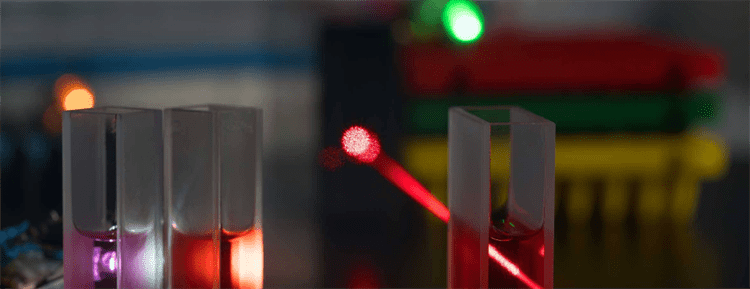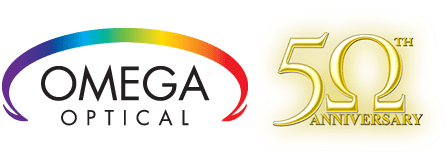
The field of applications and instrumentation that utilize laser sources is quickly advancing. For example, confocal and multiphoton microscopy, Raman spectroscopy, and flow cytometry all make use of laser sources.
In each of these methods, it is essential that all undesirable plasma, background, and laser scatter are removed in order to attain optimum signal-to-noise.
Laser line and short pass edge filters can be used to ‘clean-up’ the signal at the laser source. Longpass edge and laser rejection filters can be employed for the rejection of unwanted noise at the detector.
A combination of solutions involving laser filters can provide better performance than holographic notch filters at a heavily reduced cost.
Each laser filter is designed with a high threshold for laser damage of up to 1 watt per cm2.
Laser Line Filters
While the output is usually thought to be monochromatic and is outlined by a prominent line and a single output wavelength at the laser source, background errors can be introduced by the inclusion of lower level plasma, transitions, and ‘glows’.
Laser sources can also change in wavelength depending on the power, temperature, and even manufacturing restrictions. The transmission of pure excitation energy requires a laser ‘clean-up’ filter to control undesired energy.
Focused on the laser’s resonance, laser line filters are narrow bandpass filters that reduce the background plasma and secondary emissions that often contribute to incorrect signals.
These filters can be used to increase the monochrome of the light output when utilizing diode lasers and LEDs. Taking gas lasers as an example, these filters can eliminate plasma in the deep blue wavelength region.
Laser line filters provide spectral control from 0.85 to 1.15 of the CWL and a 60 to 90% throughput (aside from UV). To control a much wider spectral range, from the deep UV to the IR, an accessory blocker can be provided. This additional blocker generates a negligible loss of throughput (less than 20%).
Laser Edge Filters
Both the unwanted scatter and the wanted signal will be found at the detector, with the orders of magnitude of the signal being smaller than the scatter.
Scatter is generated by tiny irregularities and characteristics of the system optics and application, for example uncontrolled light from the sample and holder.
Laser rejection filters and edge filters can be used to reduce or stop the scattered energy from reaching the detector in order to increase signal to noise.
Longpass edge filters are a superior solution for laser rejection when used in a collimated light path on the system’s detector area.
They weaken shorter wavelengths to around 0.7 l edge or the deep UV for l less than approximately 500nm. They also exhibit high throughput of the Raman signal, deep blocking of the laser line (an OD that is more than 5) and display steep slopes (less than 3% on the 5-Decade slope factor).
An estimated 85% of Stokes, anti-Stokes fluorescence, or Raman signal will be transmitted by edge filters that outline a very high contrast between the Rayleigh and Raman transmission. They are constructed with edges detailed as 1.03 x the wavelength of the laser.
Angle tuning is required for optimal performance. The edge filter performance is stronger than low throughput monochromators and holographic notch filters at a significantly decreased price.
Angle Tuning Edge Filters
Angle tuning can be utilized on all edge filters to achieve the maximum signal-to-noise. When the filter is angle tuned, the transmission curve will blue-shift.
Angle tuning allows Raman signals that are close to the laser line to travel through the filter, which results in blocking at the laser line. The filter can be set up to approximately 15 degrees from normal incidence.
The cut-on wavelength of the longpass edge filter at a 15-degree angle of incidence will blue shift by approximately 1% of the cut-on value at normal incidence.
A filter with normal orientation that cuts on at 600 nm will cut on when positioned to 15 degrees at 594 nm. The laser line blocking will decrease by approximately two optical densities as a consequence of this blue shift.
A further effect of angle tuning is the redirection of reflected energy at the optical axis. For longpass edge filters, a filter should be selected to contain an edge that is to the red of the target cut-off, and the filter angle should be modified until the desired performance is achieved.
An additional choice for achieving a greater transmission at small Raman shifts is to use two filters in succession, each set up to block the laser line at OD levels of 2 to 3.
When used all at once, additive blocking at the laser line (an OD of 4 to 6) will occur, and the 5-decade slope factor is effectively decreased from 3% to as little as 1.5%.
Laser Rejection Filters
Both signal and scatter will be found at the detector, with the signal orders of magnitude being smaller than the scatter.
To enhance signal-to-noise, both laser rejection filters and edge filters can be used to diminish, or prevent, the scattered energy from reaching the detector.
Laser rejection filters are produced to block more than 99.9% of light in a 15 to 40 nm bandwidth. Outside of the top band, the standard transmission rate is 75%, aside from spectral areas where higher and lower harmonics produce comparatively high reflection.
Specially designed rejection band filters can reflect several spectral bands and perform at off-normal angles of incidence. Notch, or rejection, filters provide the ability to measure both anti-Stokes and Stokes signals simultaneously and have the tunability for various laser lines.
Edge filters can equally be used for laser rejection, providing deeper blocking of the laser line and steeper edges, for smaller Stokes shifted applications.

This information has been sourced, reviewed and adapted from materials provided by Omega Optical, Inc.
For more information on this source, please visit Omega Optical, Inc.